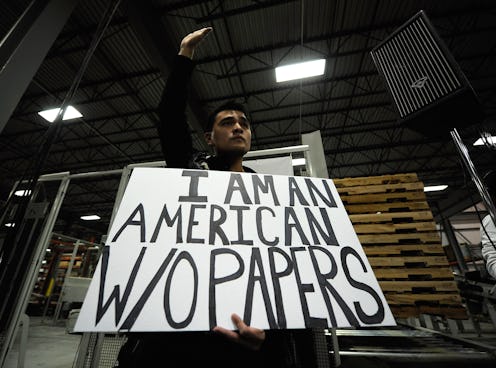News
Who Is Jose Antonio Vargas? 5 Things To Know
On Tuesday, openly-undocumented journalist and activist Jose Antonio Vargas was released by border authorities after being detained in Texas due to his lack of American citizenship. Vargas, one of the most public voices for immigration reform, had been traveling to Texas to visit some of the 70,000 or so undocumented children at detention facilities around the border and partake in a candlelight vigil. He has a Filipino passport but no current U.S. visa, and so far, he’s not saying why he was released.
Vargas got quite a bit of attention for his 2011 New York Times op-ed, wherein he went public with his status as an undocumented worker and explained in detail how difficult it is to live in America without proper citizenship. Now, he’s an activist for comprehensive immigration reform, and as immigration has emerged as one of the biggest issues on the political radar, you’ll surely be hearing more from him over the next couple of months.
But in the event that you can’t remember exactly who Vargas is — or, alternatively, if you hadn’t even heard of him in the first place — here’s a quick primer. While his success as a journalist is somewhat unique, his experience as an undocumented worker is not.
He Came To America When He Was 12
Vargas was born in the Philippines. In 1993, when he was 12, his mother put him on a plane to America with a man she referred to as his “uncle.” It wasn’t actually his uncle: This man was a coyote, someone who makes a living smuggling people across the Mexican-U.S. border. Vargas’s grandparents were already naturalized U.S. citizens, and they’d paid the coyote $4,500 (which is a lot of money even now, let alone in 1993) to sneak their grandson into the U.S. using a fake passport. Once Vargas entered the country without issue, he moved into his grandparents’ home in Mountain View, CA and quickly fell in love with the new country.
He Didn’t Know He Was Undocumented Until He Was 16
However, like many immigrants who come to the U.S. as children, Vargas didn’t know he wasn’t a citizen until years after his arrival. It was a DMV clerk who broke the bad news: When 16-year-old Vargas presented his green card — which his grandfather had given him — in an attempt to get a driver’s license, the clerk told him it was fake and whispered for him to get out of there as soon as possible. Vargas soon discovered that his green card, passport, and student visa were all counterfeits, purchased by his grandfather shortly after his arrival.
Vargas has since written extensively about his experiences falsifying citizenship documents. He used his fake passport to apply for a Social Security number; that got him a Social Security card, but it had the words “valid for work only with I.N.S. authorization,” so Vargas photocopied it with a paper strip covering those incriminating words. In order to get a driver’s license, he researched which state had the most lenient requirements for one (Oregon), then used a friend’s address there and claimed it was his own.
He’s A Very Well-Respected Journalist
Vargas isn’t famous simply because he’s an undocumented immigrant who went public. He’s also an accomplished journalist, and had received acclaim as a reporter years before making a name for himself as an immigration activist. A longtime writer for the Washington Post, Vargas received a Pulitzer Prize for his reporting on the Virginia Tech shootings in 2008, and his coverage of HIV in Washington formed the basis for a 2010 documentary, The Other City . He profiled Mark Zuckerberg for the New Yorker and wrote a front page Post article about Wikipedia’s role in the 2008 election.
coming out as gay was easier for him than coming out as undocumented
Complicating the matter of Vargas' undocumented status was the fact that Vargas is gay. His grandfather’s plan was for him to obtain citizenship by marrying an American, but gay marriage was still federally prohibited at that point, and so that option was off of the table. Vargas came out as gay when he was 16, an experience that he said was “less daunting” than coming out as undocumented.
Vargas says that this professional success made his life even more stressful. For one, he had to do his best to avoid covering any immigration stories, but more broadly, he was in the impossible situation of having to simultaneously stand out (as a journalist) and blend in (as an undocumented worker). Luckily for him, the few employers in whom he confided were understanding of his situation, but that didn’t eliminate the constant threat of deportation. Furthermore, his Oregon driver’s license — which he’d relied on to get jobs — would expire when he turned 30.
it's unlikely he'll ever actually be deported
Because of his celebrity status, (and several other reasons detailed by Mother Jones), it is unlikely Vargas will actually ever be deported. Still, at the time he came out as undocumented, Vargas was clearly taking a huge risk. In 2011, he published a piece in the New York Times Magazine about living as an undocumented worker in America, which quickly went viral and won him another journalism award. He also produced a film about his experiences and founded Define American, a non-profit that aims solely to promote dialogue about immigration, citizenship, and what it means to be an American. He also gave a very popular TED talk on the need for immigration reform.
Vargas is a vocal proponent of the DREAM Act, and has emerged as one of the most visible activists for immigration reform. In every sense but the legal one, he has lived, and is living, the American dream.
